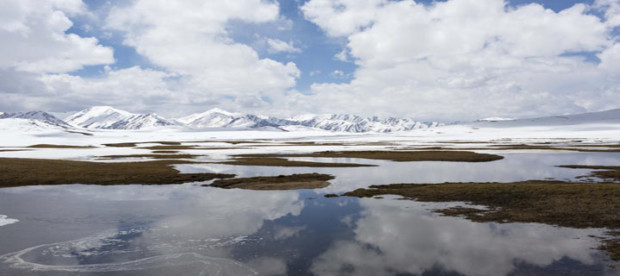The Earth Has a Third Pole—And Millions of People Use Its Water
When we think of the impact of climate change on the world’s ice, we usually think first of the North and South Poles. And for good reason: Greenland and Antarctica’s huge ice sheets hold roughly 75 percent of the world’s fresh water. Warming temperatures in both regions is already causing dangerous amounts of that ice to melt in coming decades. But the poles aren’t the only ice storehouses threatened by climate change— there’s another in Central Asia that’s so large it’s often called the Third Pole.
Overlapping heavily with snow leopard habitat, the Third Pole encompasses the snow-covered mountains surrounding the Tibetan Plateau. It holds the largest store of permanent ice and permafrost outside the poles themselves. The region also contains the world’s highest peaks, an incredible variety of ethnic communities, and stunning biodiversity (including endangered snow leopards). The Pole’s thousands of glaciers and regular snow melt form the headwaters for 10 of Asia’s biggest rivers, which bring drinking water, power and irrigation directly to 210 million people, while these river basins indirectly support more than 1.3 billion people. པརSnow leopards are found in 12 countries—including China, Bhutan, Nepal, India, Pakistan, Afghanistan, Russia, and Mongolia—but their population is dropping. Impacts from climate change could result in a loss of up to 30 percent of the snow leopard habitat in the Himalayas alone.
But warming temperatures are eating away at that reserve, causing many of the Third Pole’s glaciers to shrink, seasonal snow to melt rapidly, and thawing Tibet’s vast stores of permafrost. That rapid melting and thawing is changing the landscape and posing risks for communities and species in the region—threatening livelihoods, food sources and water security.
In 2012, WWF launched a four-year, USAID-funded project to help communities and wildlife adapt to changes in the region. Through the Conservation and Adaptation in Asia’s High Mountain Landscapes and Communities project, WWF staff are conducting a large-scale climate vulnerability assessment in six countries in the region (Bhutan, India, Nepal, Mongolia, Kyrgyzstan, and Pakistan) to improve local communities’ climate change adaptation strategies and water security, as well as creating an interactive Third Pole “geolab” to share knowledge. The project also focuses on conserving the region’s iconic snow leopard, because the intertwined ecosystems that create snow leopard habitat are crucial to the region’s adaptation and water security.
By embracing sustainable, climate-smart practices and reducing human-wildlife conflict, communities are protecting these ecosystems and their (and the snow leopards’) futures. In addition to on-the-ground work, the project works at a higher level fostering regional alliance for conserving the landscapes of the Third Pole—snow and ice included.
source. WWF
The link for this article. http://www.worldwildlife.org/stories/the-earth-has-a-third-pole-and-millions-of-people-use-its-water



comment 0